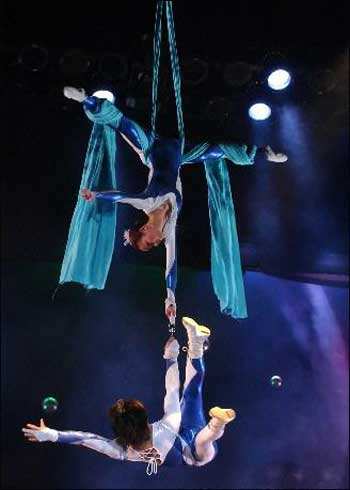Thrilling Aerial Acrobatics
3 min readThe major aerial acrobatics such as “the dwarf climbing up the pole”and “Dai gan”have been mentioned in the preceding part. By the Han dynasty there emerged more aerial acrobatic shows, such as pole maneuvering, chariot riding, rope walking and so on.
Climbing up the pole was prevalent in the Han dynasty. The historical documents and cultural relics indicate that such an art was mainly played either on the level ground or on the chariot.
A lot of cultural relics feature the performance of climbing up the pole from the level ground, for instance, the stone portrait unearthed form a tomb of the Han dynasty in the south of Mountain Wei, Shandong Province portrays seven acrobats dealing with poles. In the portrait there are five bamboo poles, three of which stand upright on the level ground and the remaining two poles link with the threeupright ones at a certain angle. The seven acrobats are in different postures: some stand upside down relying on both hands; some stand upside down relying on a single hand and some hang down with a single hand on the pole. It is obvious that at that time the aerial acrobatics were not performed by a single acrobat with a single pole, but more often by multiple acrobats with multiple poles. The stone carving at Yinan portrays the Chuangji of Dai gan: one performer plants a pole on his forehead.

and keeps the pole upright by adjusting the pole’s center of gravity. High up the pole is fixed with a cross-shaped bar and atop the pole is a small dish upon whicl another performer lies and on either end of the bar hangs an acrobat upside down.
Besides the performing mode on the level ground the performing mode on the chariot has been found in a lot of historical documents. Xijing Fu relates a kid adept at aerial acrobatics hangs himself upside down with his feet buckled at the pole and it seems he is on the point of toppling down. Such an action is very dangerous, striking terror into the heart of the spectators. And the performance onthe chariot can be detected from the stone carving themed on the variety shows at Yinan: on the chariot are set two poles and two boards; the acrobat performs a somersault from the front pole to land on the back board and the slightest carelessness of the acrobat may cost him a heavy fall off the board. Such an act is still a component of today’s acrobatics, similar to “flipping to the chariot.”Rope walking is another variety of aerial acrobatics. In Li You’s words, it was “walking on the rope at a certain height”and it enjoyed wide popularity in the Handynasty. In the beginning the prop for the rope walking was quite simple since only a thick rope tied between two pillars was needed. Later on other props were added for the rope walking as recorded in the stone carving at Yinan: between two pillars is tied a thick rope around which are fastened with four swords with their sharp blades upward to enhance the thrilling atmosphere, and two female acrobats from either end of the rope come dancing face to face. The Pingle Stand Fu records evenmore complex acts such as leaping and whirling, which shows that the performers on the rope can leap or even gracefully dance along instead of walking only. So it can be concluded that in the Han dynasty the aerial acrobatics attained to a high state.








